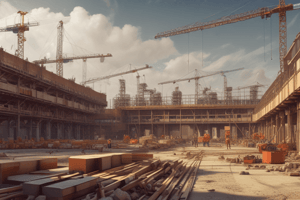Podcast
Questions and Answers
What is the primary focus of construction economics?
What is the primary focus of construction economics?
- Designing construction projects
- Studying the economic aspects of construction projects (correct)
- Supervising construction labor
- Managing construction equipment
What is preliminary estimation in construction?
What is preliminary estimation in construction?
- Determining the quantities of materials needed for the project
- Rough cost estimation in the early stages of project planning (correct)
- Competitive estimate submitted by a contractor
- In-depth analysis of costs based on detailed project plans
What is the purpose of cost analysis in construction economics?
What is the purpose of cost analysis in construction economics?
- To design construction projects
- To manage construction equipment
- To evaluate the costs associated with construction (correct)
- To supervise construction labor
What is a key component of project financing in construction economics?
What is a key component of project financing in construction economics?
What is bid estimation in construction?
What is bid estimation in construction?
What is a factor that influences construction economics and estimation?
What is a factor that influences construction economics and estimation?
What is unit cost estimation in construction?
What is unit cost estimation in construction?
What is quantity takeoff in construction estimation?
What is quantity takeoff in construction estimation?
Who initiates and funds a construction project?
Who initiates and funds a construction project?
What is the primary role of an Architect/Designer in a construction project?
What is the primary role of an Architect/Designer in a construction project?
Why is estimation crucial in the construction industry?
Why is estimation crucial in the construction industry?
Who provides funding and financial support for a construction project?
Who provides funding and financial support for a construction project?
What is the primary role of a Project Manager in a construction project?
What is the primary role of a Project Manager in a construction project?
What is the purpose of a feasibility study in a construction project?
What is the purpose of a feasibility study in a construction project?
Who are responsible for enforcing building codes and zoning regulations?
Who are responsible for enforcing building codes and zoning regulations?
What is the purpose of competitive bidding in a construction project?
What is the purpose of competitive bidding in a construction project?
Why is accurate estimation essential in a construction project?
Why is accurate estimation essential in a construction project?
What is the role of Engineers in a construction project?
What is the role of Engineers in a construction project?
What is the primary goal of applying construction economics in construction projects?
What is the primary goal of applying construction economics in construction projects?
What is the term for the process of identifying, estimating, and controlling costs in construction projects?
What is the term for the process of identifying, estimating, and controlling costs in construction projects?
What is the concept that recognizes the value of money changes over time in construction projects?
What is the concept that recognizes the value of money changes over time in construction projects?
What is the purpose of including a contingency allowance in construction projects?
What is the purpose of including a contingency allowance in construction projects?
What is the term for the process of evaluating whether a project's benefits justify its costs?
What is the term for the process of evaluating whether a project's benefits justify its costs?
What is the concept that examines the total cost of ownership over a project's life cycle?
What is the concept that examines the total cost of ownership over a project's life cycle?
What is the primary benefit of using Building Information Modeling (BIM) in construction projects?
What is the primary benefit of using Building Information Modeling (BIM) in construction projects?
What is the term for the process of finding ways to optimize costs without compromising project quality?
What is the term for the process of finding ways to optimize costs without compromising project quality?
What is the primary challenge in construction economics and estimations due to changes in market conditions?
What is the primary challenge in construction economics and estimations due to changes in market conditions?
What is the importance of maintaining detailed records of costs, changes, and unforeseen events in construction projects?
What is the importance of maintaining detailed records of costs, changes, and unforeseen events in construction projects?
What is the benefit of including contingency allowances in project estimation?
What is the benefit of including contingency allowances in project estimation?
What is the primary purpose of accurate estimates in project management?
What is the primary purpose of accurate estimates in project management?
What is the benefit of using estimations as a baseline for cost control?
What is the benefit of using estimations as a baseline for cost control?
What is the unit of measurement for the length of a steel reinforcement bar?
What is the unit of measurement for the length of a steel reinforcement bar?
What is the unit of measurement for the thickness of a woodwork?
What is the unit of measurement for the thickness of a woodwork?
What is the unit of measurement for the weight of a material?
What is the unit of measurement for the weight of a material?
What is the unit of measurement for the area of a material?
What is the unit of measurement for the area of a material?
What is the purpose of IS Code 1200 in construction?
What is the purpose of IS Code 1200 in construction?
What is the primary benefit of accurate estimates in project management?
What is the primary benefit of accurate estimates in project management?
What is the purpose of including contingency allowances in project estimation?
What is the purpose of including contingency allowances in project estimation?
What is the unit of measurement for the length of a steel reinforcement bar?
What is the unit of measurement for the length of a steel reinforcement bar?
What is the unit of measurement for the thickness of a woodwork?
What is the unit of measurement for the thickness of a woodwork?
What is the unit of measurement for the weight of a material?
What is the unit of measurement for the weight of a material?
What is the unit of measurement for the area of a material?
What is the unit of measurement for the area of a material?
What is the purpose of IS Code 1200 in construction?
What is the purpose of IS Code 1200 in construction?
What is the primary benefit of using estimates as a baseline for cost control?
What is the primary benefit of using estimates as a baseline for cost control?
What is the primary objective of construction economics?
What is the primary objective of construction economics?
What is the key difference between a preliminary estimate and a detailed estimate?
What is the key difference between a preliminary estimate and a detailed estimate?
What is the primary factor that influences the cost of construction materials?
What is the primary factor that influences the cost of construction materials?
What is the purpose of quantity takeoff in construction estimation?
What is the purpose of quantity takeoff in construction estimation?
What is the key component of project financing in construction economics?
What is the key component of project financing in construction economics?
What is the primary role of supply and demand in construction economics?
What is the primary role of supply and demand in construction economics?
What is the primary benefit of managing construction costs effectively?
What is the primary benefit of managing construction costs effectively?
What is the primary challenge in construction economics and estimations due to changes in labor costs?
What is the primary challenge in construction economics and estimations due to changes in labor costs?
What is the primary objective of cost management in construction economics?
What is the primary objective of cost management in construction economics?
Which of the following is a key concept in construction economics that examines the total cost of ownership over a project's life cycle?
Which of the following is a key concept in construction economics that examines the total cost of ownership over a project's life cycle?
What is the primary benefit of including a contingency allowance in construction projects?
What is the primary benefit of including a contingency allowance in construction projects?
Which of the following is a challenge in construction economics and estimations due to changes in market conditions?
Which of the following is a challenge in construction economics and estimations due to changes in market conditions?
What is the primary role of Building Information Modeling (BIM) in construction projects?
What is the primary role of Building Information Modeling (BIM) in construction projects?
What is the primary objective of value engineering in construction projects?
What is the primary objective of value engineering in construction projects?
Which of the following is a key concept in construction economics that recognizes the value of money changes over time?
Which of the following is a key concept in construction economics that recognizes the value of money changes over time?
What is the primary purpose of maintaining detailed records of costs, changes, and unforeseen events in construction projects?
What is the primary purpose of maintaining detailed records of costs, changes, and unforeseen events in construction projects?
Which of the following is a key concept in construction economics that involves the evaluation of whether a project's benefits justify its costs?
Which of the following is a key concept in construction economics that involves the evaluation of whether a project's benefits justify its costs?
What is the primary purpose of using estimation software in construction projects?
What is the primary purpose of using estimation software in construction projects?
What is the primary role of a Contractor in a construction project?
What is the primary role of a Contractor in a construction project?
Why is estimation crucial in the construction industry?
Why is estimation crucial in the construction industry?
Who determines the project objectives and approves budgets in a construction project?
Who determines the project objectives and approves budgets in a construction project?
What is the purpose of identifying and managing stakeholders in a construction project?
What is the purpose of identifying and managing stakeholders in a construction project?
What is the role of Government Authorities/Regulatory Bodies in a construction project?
What is the role of Government Authorities/Regulatory Bodies in a construction project?
Why is it important to conduct a feasibility study in a construction project?
Why is it important to conduct a feasibility study in a construction project?
What is the benefit of accurate estimation in a construction project?
What is the benefit of accurate estimation in a construction project?
Who plays a crucial role in the planning, design, and implementation of various aspects of a construction project?
Who plays a crucial role in the planning, design, and implementation of various aspects of a construction project?
What is the purpose of estimation in resource planning?
What is the purpose of estimation in resource planning?
Who are the end-users or occupants of a construction project?
Who are the end-users or occupants of a construction project?
Flashcards are hidden until you start studying
Study Notes
Construction Economics & Estimations
- Construction economics involves the study of economic aspects and principles related to construction projects.
- Key components of construction economics include cost analysis, supply and demand, and project financing.
Estimations
- Estimation is the process of predicting the costs, time, and resources required for a construction project.
- Types of estimations include:
- Preliminary estimate: rough cost estimation done in the early stages of project planning
- Detailed estimate: in-depth analysis of costs based on detailed project plans and specifications
- Bid estimate: a competitive estimate submitted by a contractor in response to a project's bid
Factors Influencing Construction Economics and Estimations
- Materials: prices and availability of construction materials
- Labor: costs associated with hiring and managing skilled and unskilled labor
- Equipment: expenses related to the use of construction machinery and tools
- Market Conditions: economic trends, inflation, and local market conditions affecting costs
- Project Scope: the size, complexity, and nature of the project
- Location: geographic factors that may impact logistics and costs
Key Processes in Estimations
- Quantity takeoff: determining the quantities of materials needed for the project based on drawings and specifications
- Unit cost estimation: assigning costs to each unit of work or material
- Overhead and profit: adding overhead costs (indirect expenses) and profit margin to the direct costs
- Contingency: including a contingency allowance for unforeseen circumstances or changes
Software and Tools
- Estimation software: utilizing specialized software like ProEst, Sage Estimating, or BuildingConnected for accurate and efficient estimations
- Building Information Modeling (BIM): integrating BIM technology for 3D modeling and collaborative project planning
Challenges in Construction Economics and Estimations
- Uncertainties: changes in market conditions, project scope, or unexpected events
- Inaccurate Information: insufficient or inaccurate data in project plans and specifications
- Regulatory Changes: changes in regulations impacting construction practices
Continuous Monitoring and Adaptation
- Cost control: regularly monitoring project costs and adjusting the budget as needed
- Value engineering: finding ways to optimize costs without compromising project quality
Documentation
- Detailed records: maintaining accurate records of costs, changes, and unforeseen events for future reference
Concept of Construction Economics
- Construction economics is a specialized branch of economics that focuses on the economic aspects of the construction industry.
- Key concepts associated with construction economics include:
- Resource allocation: efficient allocation of resources to maximize output while minimizing costs
- Cost management: identification, estimation, and control of costs associated with construction projects
- Supply and demand dynamics: understanding the market forces that influence the supply and demand for construction services, materials, and labor
- Risk analysis and management: evaluation, quantification, and management of risks
- Time value of money: recognizing the value of money changes over time
- Financial viability and feasibility: assessing the financial viability and feasibility of construction projects
- Life cycle costing: examining the total cost of ownership over a project's life cycle
- Government policies and regulations: considering the impact of government policies, regulations, and incentives on construction activities
- Sustainability and green construction: considering the economic implications of green construction methods and materials
Stakeholders of Construction Project
- Owner/client: the individual or organization that initiates and funds the construction project
- Project manager: responsible for overall project planning, execution, and completion
- Contractor: the entity responsible for executing the construction work
- Architect/designer: designs the project, develops plans, and ensures that the construction meets specified standards and regulations
- Engineers: civil, structural, mechanical, and electrical engineers play crucial roles in the planning, design, and implementation of various aspects of the construction project
- Consultants: external experts hired to provide specialized advice
- Government authorities/regulatory bodies: agencies responsible for enforcing building codes, zoning regulations, and other legal requirements
- Financial institutions: provide funding and financial support for the construction project
- End users/occupants: individuals or organizations for whom the construction project is being undertaken
Need of Estimation
- Budgeting: cost planning and forecasting
- Project feasibility: financial viability and feasibility assessment
- Decision-making: informed decision-making based on accurate estimates
- Competitive bidding: bid preparation and submission
- Resource planning: materials, labor, and equipment planning
- Project scheduling: time estimation and project timeline development
- Risk management: identification of contingencies and risk management
- Client communication: transparency and client satisfaction
- Financial control: cost control and financial management
Units of Measurement as per IS1200
- Dimension: measured to the nearest 0.01 m
- Area: worked out to the nearest 0.01 sq.m
- Cubic content: calculated to the nearest 0.01 cu.m
- Weight: worked out to the nearest 0.001 tonnes
- Thickness of RCC slab: measured to the nearest 0.005 m
- Thickness of woodwork: measured to the nearest 0.002 m
- Thickness of steelwork: measured to the nearest 0.001 m
- Length of steel reinforcement bar: measured to the nearest 0.005 m
- Diameter of steel reinforcement bar: measured to the nearest 0.0001 m
Construction Economics & Estimations
- Construction economics involves the study of economic aspects and principles related to construction projects.
- Key components of construction economics include cost analysis, supply and demand, and project financing.
Estimations
- Estimation is the process of predicting the costs, time, and resources required for a construction project.
- Types of estimations include:
- Preliminary estimate: rough cost estimation done in the early stages of project planning
- Detailed estimate: in-depth analysis of costs based on detailed project plans and specifications
- Bid estimate: a competitive estimate submitted by a contractor in response to a project's bid
Factors Influencing Construction Economics and Estimations
- Materials: prices and availability of construction materials
- Labor: costs associated with hiring and managing skilled and unskilled labor
- Equipment: expenses related to the use of construction machinery and tools
- Market Conditions: economic trends, inflation, and local market conditions affecting costs
- Project Scope: the size, complexity, and nature of the project
- Location: geographic factors that may impact logistics and costs
Key Processes in Estimations
- Quantity takeoff: determining the quantities of materials needed for the project based on drawings and specifications
- Unit cost estimation: assigning costs to each unit of work or material
- Overhead and profit: adding overhead costs (indirect expenses) and profit margin to the direct costs
- Contingency: including a contingency allowance for unforeseen circumstances or changes
Software and Tools
- Estimation software: utilizing specialized software like ProEst, Sage Estimating, or BuildingConnected for accurate and efficient estimations
- Building Information Modeling (BIM): integrating BIM technology for 3D modeling and collaborative project planning
Challenges in Construction Economics and Estimations
- Uncertainties: changes in market conditions, project scope, or unexpected events
- Inaccurate Information: insufficient or inaccurate data in project plans and specifications
- Regulatory Changes: changes in regulations impacting construction practices
Continuous Monitoring and Adaptation
- Cost control: regularly monitoring project costs and adjusting the budget as needed
- Value engineering: finding ways to optimize costs without compromising project quality
Documentation
- Detailed records: maintaining accurate records of costs, changes, and unforeseen events for future reference
Concept of Construction Economics
- Construction economics is a specialized branch of economics that focuses on the economic aspects of the construction industry.
- Key concepts associated with construction economics include:
- Resource allocation: efficient allocation of resources to maximize output while minimizing costs
- Cost management: identification, estimation, and control of costs associated with construction projects
- Supply and demand dynamics: understanding the market forces that influence the supply and demand for construction services, materials, and labor
- Risk analysis and management: evaluation, quantification, and management of risks
- Time value of money: recognizing the value of money changes over time
- Financial viability and feasibility: assessing the financial viability and feasibility of construction projects
- Life cycle costing: examining the total cost of ownership over a project's life cycle
- Government policies and regulations: considering the impact of government policies, regulations, and incentives on construction activities
- Sustainability and green construction: considering the economic implications of green construction methods and materials
Stakeholders of Construction Project
- Owner/client: the individual or organization that initiates and funds the construction project
- Project manager: responsible for overall project planning, execution, and completion
- Contractor: the entity responsible for executing the construction work
- Architect/designer: designs the project, develops plans, and ensures that the construction meets specified standards and regulations
- Engineers: civil, structural, mechanical, and electrical engineers play crucial roles in the planning, design, and implementation of various aspects of the construction project
- Consultants: external experts hired to provide specialized advice
- Government authorities/regulatory bodies: agencies responsible for enforcing building codes, zoning regulations, and other legal requirements
- Financial institutions: provide funding and financial support for the construction project
- End users/occupants: individuals or organizations for whom the construction project is being undertaken
Need of Estimation
- Budgeting: cost planning and forecasting
- Project feasibility: financial viability and feasibility assessment
- Decision-making: informed decision-making based on accurate estimates
- Competitive bidding: bid preparation and submission
- Resource planning: materials, labor, and equipment planning
- Project scheduling: time estimation and project timeline development
- Risk management: identification of contingencies and risk management
- Client communication: transparency and client satisfaction
- Financial control: cost control and financial management
Units of Measurement as per IS1200
- Dimension: measured to the nearest 0.01 m
- Area: worked out to the nearest 0.01 sq.m
- Cubic content: calculated to the nearest 0.01 cu.m
- Weight: worked out to the nearest 0.001 tonnes
- Thickness of RCC slab: measured to the nearest 0.005 m
- Thickness of woodwork: measured to the nearest 0.002 m
- Thickness of steelwork: measured to the nearest 0.001 m
- Length of steel reinforcement bar: measured to the nearest 0.005 m
- Diameter of steel reinforcement bar: measured to the nearest 0.0001 m
Studying That Suits You
Use AI to generate personalized quizzes and flashcards to suit your learning preferences.





